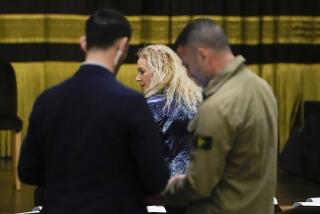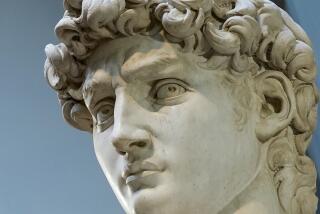‘Mafia Terror’ Blamed in Blast at Italy Museum
ROME — A terrorist bomb that killed five people outside Florence’s Uffizi Palace early Thursday destroyed several minor 17th-Century works of Italian art and damaged some works by renowned artists but left the museum’s most famous paintings and sculptures unharmed.
Italy’s interior minister promptly called the bombing the work of “Mafia terrorism” at a time when Italian authorities are waging their most successful campaign ever against organized crime.
The bomb, planted in a parked car that had been stolen hours earlier, dug a crater 10 feet wide and 6 feet deep between the 16th-Century Uffizi Palace and an agricultural archive across the street. Police said they had a description of a man who walked away from the car shortly before the blast.
The explosion demolished the four-story archive building, killing its custodian, her husband, their 8-year-old daughter and their 9-month-old baby. Police found an additional body, that of a 22-year-old architecture student who lived across an alley from the Uffizi’s heavily damaged west wing. About 30 people were injured.
The Uffizi was less severely damaged than the archive building, although most of its windows were blown out by the force of the blast. Museum officials said that recently installed bulletproof glass had protected some of the gallery’s best-known paintings, most of them located a considerable distance from the blast, from flying debris.
The museum houses Italy’s most precious art collection, including Sandro Botticelli’s “Birth of Venus,” Leonardo da Vinci’s “Adoration of the Magi” and Michelangelo’s “Doni Tondo,” his only completed oil painting. Also in the collection is the “Medici Venus,” a 2,000-year-old marble sculpture that had been in the collection of Florence’s ruling Medici family.
The three paintings that were destroyed were the “Birth of Christ” by Gherardo Delle Notti and “Buonaventura” and “Ciclo Viti” by Bartolomeo Manfredi.
Among those damaged, mostly by flying glass, were works by the 17th-Century Flemish masters Peter Paul Rubens and Anthony Van Dyck.
In the sculpture collection, the legs were blown off a Roman statue of the weeping Greek goddess Niobe, distraught over the murder of her 12 children who were killed by Apollo and Artemis.
Uffizi Director Anna Maria Petrioli Tofani said that all the damaged statues could be restored. She estimated the damage at “millions of dollars.”
The massive palace, constructed in 1560 for Cosimo I, one of the Medici dukes, is itself a work of art. “The building itself has suffered major structural damage,” Francesco Sisinni, director general of the Culture Ministry, said.
Sisinni said the palace will be closed for at least two months. Workers quickly removed the paintings from the third-floor galleries, which hold the museum’s most precious works, before rain could pour in through broken skylights and cause more damage.
The archive across the street from the Uffizi Palace, the Accademia dei Georgofili, is the oldest such academy in the world. It housed thousands of centuries-old agricultural documents, many of which were buried under rubble left by the bomb.
Also damaged was the “Madonna alla Costa,” completed in 1300 by the Italian master Giotto. That work was in a 12th-Century church behind the agricultural archive.
“We wonder what devils or demons want to strike at Florence, the heart of our history and of world culture,” movie producer Franco Zeffirelli said. “We’re on the verge of an apocalypse. This is an attack on . . . the cultural identity of the world.”
Thursday’s bombing, shortly after 1 a.m. local time, bore striking resemblance to the bombing in the posh Roman neighborhood of Parioli 13 days earlier. That explosion, also a car bomb, left a huge crater and injured 23 people.
“It’s Mafia terrorism,” said Interior Minister Nicola Mancino. “There are similarities” with the Parioli bombing, he said, “even though the amount of explosives was probably greater” in the Florence bombing.
Mancino warned last Sunday, after a memorial service for a judge who was blown up by the Mafia last year, that Italy should expect more bombings.
Sociologist Pino Arlacchi, a consultant to the Italian government on organized crime, said: “The only destructive force that we know for sure is working in Italy now is Cosa Nostra, and at this moment it’s threatened by the state.
“We mustn’t lose our head,” Arlacchi said. “This is what the Mafia wants--to distract the forces that are involved in fighting it.”
Organized crime has been repeatedly hammered in recent months in the Italian government’s most successful counterattack against the Sicilian Mafia and its cousins on the mainland. Authorities are investigating possible connections between the Mafia and such politicians as former Prime Minister Giulio Andreotti.
Times researcher Rosanna Montalbano contributed to this story.
More to Read
Sign up for Essential California
The most important California stories and recommendations in your inbox every morning.
You may occasionally receive promotional content from the Los Angeles Times.










